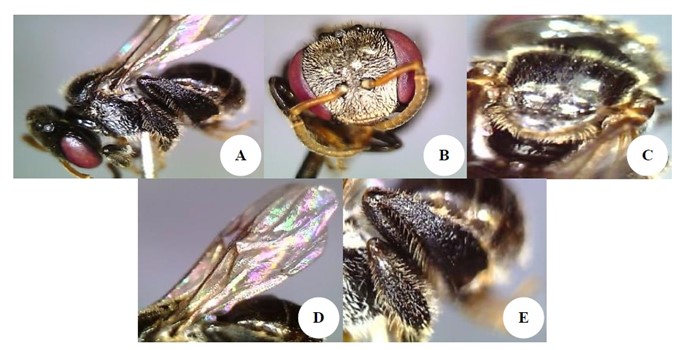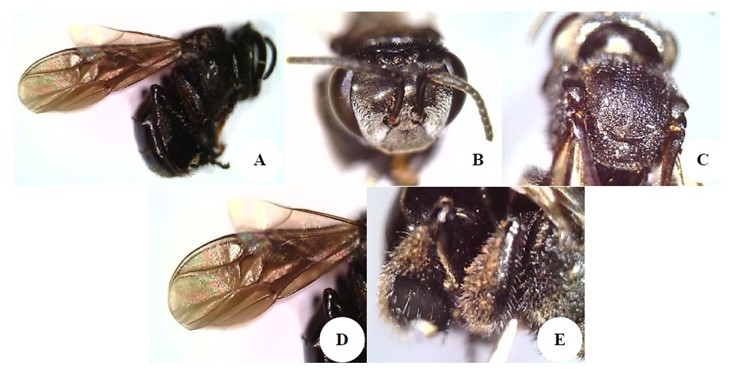Overview of Stingless Bees (Tetragonula laeviceps and Heterotrigona itama) and Related Research
07/07/2024 Views : 353
I K. Putra Juliantara
Stingless bees in Bali are locally known as "Lebah Kele." In other regions of Indonesia, they are referred to as "Lebah Klanceng" in Java, "Lebah Kelulut" in Kalimantan, "Lebah Galo-galo" in Minang, "Lebah Ketape" in South Sulawesi, and "Lebah Teuweul" in Sunda. However, nationally, they are more commonly known as "Lebah Trigona." The food sources for Lebah Kele include nectar, pollen, and resin from various plants. Lebah Kele is an insect species with excellent adaptive capabilities, making it suitable for cultivation near human settlements. Additionally, these bees thrive near agricultural land, peat swamp forests, and even mangrove forests (Wiratmoko and Janetta, 2018; Syaifudin and Normagiat, 2020; Senoaji et al., 2022).
Being stingless and easily adaptable to new environments, Lebah Kele is well-suited for tropical climates and lowland areas, provided there is a food source nearby (Senoaji et al., 2022). Some advantages of Lebah Kele over common honeybees (Apis sp.) include their diverse food source preferences (including ornamental plants, crops, forestry plants, fruits, and vegetables), the ability to extract food from grass flowers that honeybees of the genus Apis cannot access, and a higher quantity of propolis production (around 3 kg per nest) (Irwansyah, 2018; Wiratmoko and Janetta, 2018; Ridoni et al., 2020).
Morphologically (based on figure 1), the body of Tetragonula laeviceps worker bees is predominantly shiny black, with a dark brown to black abdomen. The head is black, occasionally covered with fine white hairs. The compound eyes are reddish, the ocelli are dark brown and large. The clypeus has combs and is entirely covered with fine white hairs. The antenna has 11 flagellomers, with a brownish-yellow scape, gray socket, brown pedicel, and the first to tenth flagellomers are brown with some dark portions. The mandibles have two teeth, brown and slightly dark at the basal part. The mesoscutum is black and entirely covered with yellow setae, the scutellum is entirely black and covered with yellow setae at the posterior part. The tegula is brown, and the color of the forewings is uniform. The hind wings are semi-transparent, and the wing venation is dark brown. The hind tibiae are short, the corbicula is pear-shaped, rarely covered with long setae apically but short basally, all black, and the hind basitarsi are entirely black. The first to sixth gastral tergites are entirely brown and dark brown on the dorsal part. The number of hamuli is 5 per hind wing (Trianto and Purwanto, 2020; Purwanto et al., 2022).

Figure 1. Morphology of Tetragonula laeviceps (Trianto and Purwanto, 2020)
In Heterotrigona itama (Figure 2), the body of worker bees is predominantly intense black. The abdomen is solid black. The head is black, with the front part covered in fine white hairs, and slightly thicker white hairs near the clypeus. The compound eyes and ocelli are dark. The clypeus is black and entirely covered with white hairs. The antenna consists of 11 flagellomers, with a gray socket, a black scape with brown at the base, and the pedicel along with the entire flagellum is entirely black. The mandible has a single tooth and is entirely black. The mesoscutum and scutellum are entirely black. The tegulae are intensely black. The forewings and hindwings are black, with dark brown and semi-transparent wing venation. The hind tibiae and basitarsi are entirely black. The number of hamuli is 7 per hind wing (Trianto and Purwanto, 2020; Purwanto et al., 2022).

Stingless bees, commonly known as "Lebah Kele," heavily rely on pollen and nectar as their primary food sources, along with plant resin for nest construction. The availability of plant food sources can significantly impact the development and sustainability of bee colonies. Additionally, potential nectar sources include flowering plants that produce nectar throughout the year (Wiratmoko and Janetta, 2018; Wahyuningsih et al., 2022).
The most common pollen collected by T. laeviceps in organic farming belongs to the Solanaceae and Cucurbitaceae families (Marsianih et al., 2022). Wiratmoko and Janetta (2018) identified potential food sources for stingless bees in the Kepau Jaya Special Purpose Forest Area (KHDTK), including meranti, mahang, coffee, pulai, geronggang, keruing, jelutong, rubber, durian, guava, water guava, mango, acacia, palm, coconut, oil palm, temon, senduduk, Israeli grass, sensitive plant, couch grass, and Clidemia sp. Irwansyah (2018) conducted research on food sources for stingless bees in Pelat Village, Unter Iwes District, Sumbawa Regency, West Nusa Tenggara Province, finding various plants such as walikun, kesambi, tengulun, sonokeling, guava, rajuma, bilva, fig, banyan, winong, pulai, tamarind, dadap, katimaha, mango, suren, teak, terap, winong, kedoyo, rapet, kopasanda, saliara, gegah wood, and adem ati.
A comparison of food sources for stingless bees in settlements and mountains in Mirring Polewali Village, Mandar, West Sulawesi, was also studied by Tahir et al. (2021). Food sources in settlements included maja, moringa, mangosteen, banana, langsat, teak, durian, water guava, mango, rambutan, cocoa, gamal, papaya, guava, pandan, pineapple, galangal, lime, cactus, peacock flower, chili, tomato, lemongrass, orchid, cassava, bamboo, asoka, wild sunflower, touch-me-not, wild trumpet flower. Meanwhile, food sources in the mountains were coffee, avocado, clove, banana, langsat, durian, palm, mango, rambutan, cocoa, pineapple, silk, golden trumpet flower, water lily, mimosa, chili, fern, and wild betel.
The backyard-based food sources for stingless bees in meliponiculture in West Nusa Tenggara include rambutan, mango, longan, clove, grape, palm, bridal tears, Jamaican guava, cherry, sunkist orange, mulberry, gumitir, guava, widelia, Mexican sunflower, coconut, durian, kastuba, corn, rice, avocado, cashew, soursop, dragon fruit, star fruit, fig, mangosteen, cempedak, and candlenut (Wahyuningsih et al., 2022).
References
Irwansyah, P. (2018). "Analysis of the Potential Food Sources of Trigona Bees in Pelat Village, Unter Iwes District, Sumbawa Regency, West Nusa Tenggara Province" (Undergraduate Thesis). Makassar: Universitas Muhammadyah Makassar.
Marsianih, F., Dhafir, M., & Trianto. (2022). "Pollen Collected by Tetragonula laeviceps Stingless Bees (Smith, 1857) (Hymenoptera: Apidae: Meliponini) from Central Sulawesi." Journal of Tropical Biology, 22(3), 851-856.
Purwanto, H., Soesilohadi, R. C. H., & Trianto. (2022). "Stingless Bees from Meliponiculture in South Kalimantan, Indonesia." Biodiversity, 23(3), 1254-1266.
Ridoni, R., Radam, R., & Fatriani. (2020). "Analysis of Stingless Bee (Trigona sp.) Honey Quality from Mangkauk Village, Pengaron District, Banjar Regency." Journal of Sylva Scienteae, 3(2), 346-355.
Senoaji, G., Nuryatin, N., Lukman, A. H., & Susanti, E. (2022). "Introduction to Trigona Bee Cultivation in Arga Indah Satu Village, Central Bengkulu Regency." Journal of Dinamisia, 6(4), 855-862.
Syaifudin, S. M., & Normagiat, S. (2020). "Cultivation of Trigona Bee Feed with Apiculture Agroforestry System in Anjungan Melancar Village, Mempawah Regency." Pangabdhi Scientific Journal, 6(1), 17-24.
Tahir, H., Irundu, D., & Rusmidin. (2021). "Plant Species as Food Sources for Trigona Bees in Mirring Polewali Village, Mandar, West Sulawesi." Journal of Nusa Sylva, 21(2), 39-47.
Wahyuningsih, E., Syaputra, M., Suparyana, P. K., & Lestari, A. T. (2022). "Identification of Diversity in Backyard-Based Food Sources for Bees in Meliponiculture in West Nusa Tenggara."
Wiratmoko, M. D. E., & Janetta, S. (2018). "Plant Species as Food Sources for Trigona Honey Bees in Peat Swamp Forest, Kepau Jaya Special Purpose Forest Area, Riau." National Seminar on Environmental Conservation.
